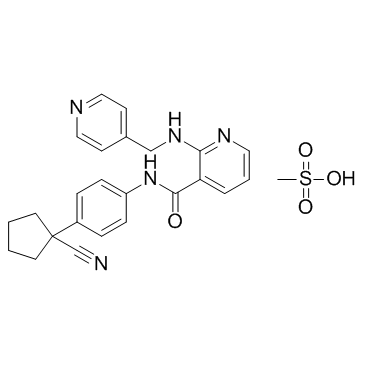1218779-75-9
| Name | N-[4-(1-Cyanocyclopentyl)phenyl]-2-[(4-pyridinylmethyl)amino]nico tinamide |
|---|---|
| Synonyms |
N-[4-(1-Cyanocyclopentyl)phenyl]-2-[(4-pyridinylmethyl)amino]nicotinamide
3-Pyridinecarboxamide, N-[4-(1-cyanocyclopentyl)phenyl]-2-[(4-pyridinylmethyl)amino]- Apatinib Mesylate Apatinib |
| Description | Apatinib is a highly selective VEGFR2 inhibitor with an IC50 of 1 nM. Apatinib also potently suppresses the activities of Ret, c-Kit and c-Src with IC50s of 13, 429 and 530 nM, respectively. |
|---|---|
| Related Catalog | |
| Target |
VEGFR2:1 nM (IC50) |
| In Vitro | Apatinib (YN968D1) slightly inhibits proliferation of HUVEC stimulated by 20% FBS (IC50=23.4 μM), whereas Apatinib significantly inhibits proliferation stimulated by 20 ng/mL VEGF (IC50=0.17 μM). The IC50 values of Sunitinib are lower under the same conditions (7.4 μM and 0.034 μM, respectively). 1 μM Apatinib significantly inhibits the migration of HUVEC induced by FBS, but does not affect proliferation of HUVEC, indicating that the inhibitory effect of Apatinib on FBS-induced migration is not due to the suppression of proliferation. At a concentration of 1 μM, Sunitinib also inhibits the migration of HUVEC[1]. |
| In Vivo | The antitumor potential of Apatinib (YN968D1) is evaluated in six human tumor xenografts in immunodeficient mice. Once-daily oral administration of Apatinib produces a dose-dependent inhibition of tumor growth in all tumor models examined. Statistically significant growth inhibition is obtained with 50 mg/kg per day Apatinib in three of five tumor xenografts tested. Each tumor xenograft model is significantly growth inhibited by Apatinib at the dose of 100 kg/day. Similar tumor growth inhibition is observed (T/C%, 8% to 18%) in mice following treatment with Apatinib at the dose of 200 kg/day. Full growth inhibition profiles are shown for three of the xenografts. Compared with the control animals, no effect of Apatinib treatment on bodyweight is observed at any dose level, which suggested that Apatinib is well tolerated[1]. |
| Cell Assay | The following human tumor cell lines are used: Ls174t, HCT 116, SGC-7901, HT-29, A549, NCI-H460, Mo7e, A431, BT474 and NIH-3T3. The cells are cultured in RPMI-1640 or DMEM supplemented with 10% FBS at 37°C with 5% carbon dioxide. Primary HUVEC are isolated from segments of normal-term cords by digestion with type I collagenase, and are pooled and cultured in Medium 199 (M199) supplemented with 20% FBS and endothelial cell growth factor. Cells in the exponential growth phase are used in the experiments. The HUVEC are seeded into 96-well plates. After 24 h of incubation, cells are exposed to the test agents (vehicle as control) together with 20 ng/mL VEGF or 20% FBS for another 72 h. After fixation with 10% trichloroacetic acid, the cells are stained with 0.4% sulforhodamine B for 30 min at 37°C and then washed with 1% acetic acid. Tris is added to dissolve the complex, and the optical density is measured at 520 nm[1]. |
| Animal Admin | Mice[1] The effects of Apatinib (YN968D1) on tumor growth are tested against various human tumors grown subcutaneously in BALB/cA nude mice. Tumor growth is initiated by subcutaneous inoculation of cells into mice. Tumors are allowed to establish and grow to 100-300 mm3, at which time the mice are randomized into experimental groups. Apatinib is administered once daily by oral gavage for the indicated periods. In combination treatment experiments, mice are administered Apatinib alone by oral gavage; 5-FU, oxaliplatin, docetaxel and doxorubicin alone by intravenous injection; or Apatinib in combination with each cytotoxic drug at the indicated dose and schedule. Tumor volume and bodyweight are monitored every other day or every 3 days, with the means indicated for groups of six (treated) or 12 (vehicle control) animals. Tumor volumes are determined by measuring the largest diameter (a) and its perpendicular (b) according to the formula (a×b2)/2. The evaluation index for inhibition is the relative tumor growth ratio according to the equation: T/C (%)=mean increase of tumor volumes of treated groups⁄mean increase of tumor volumes of control groups×100%. |
| References |
| Density | 1.3±0.1 g/cm3 |
|---|---|
| Boiling Point | 578.2±50.0 °C at 760 mmHg |
| Molecular Formula | C25H27N5O4S |
| Molecular Weight | 493.58 |
| Flash Point | 303.5±30.1 °C |
| PSA | 90.70000 |
| LogP | 3.68 |
| Vapour Pressure | 0.0±1.6 mmHg at 25°C |
| Index of Refraction | 1.652 |
| Hazard Codes | Xi |
|---|
